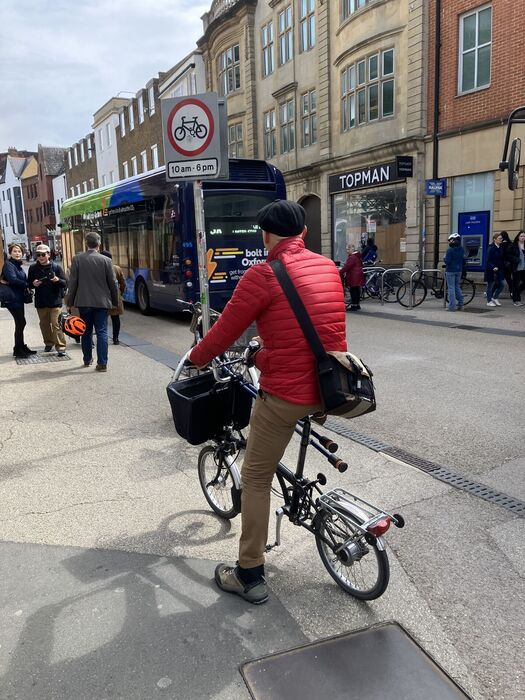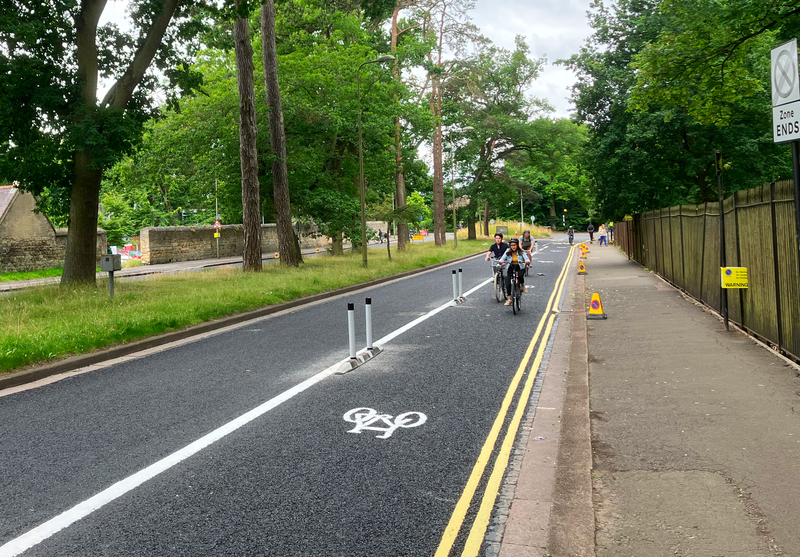The photo shows a friend of mine. He can and does cycle long distances, and he can walk with crutches, but he can't dismount and push his bike. At least half a dozen women, including my sister, have told me that they could comfortably cycle in late pregnancy when they couldn't walk any distance. And these are just the more visible examples: people can have reduced mobility without any visible sign of that.
more
There have been concerns about road danger on Barton Fields Rd, the spine road that runs through the Barton Park development on the eastern outskirts of Oxford, in particular around the primary school. One driver ploughed into the cycle parking stands outside the school, another hit one of the buildings under construction on the other side of the street, and there are a lot of other incidents that don't show up in the official road injury record. (There are also concerns about road danger at the crossing of the A40; I have written about those elsewhere.)
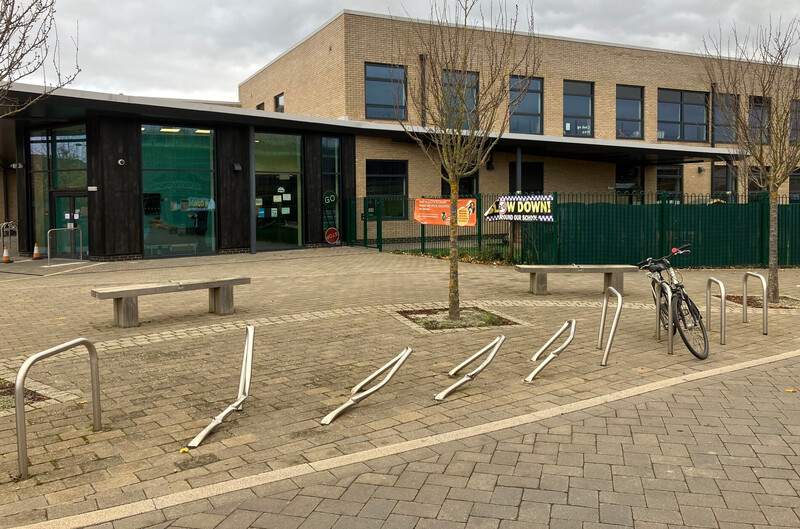
cycle parking stands outside Barton Park Primary School, bent over by being driven into
|
more
Parks Rd is a key north-south cycling route through the city centre, as well as part of National Cycle Network route 51, and its junction with South Parks Rd is currently the worst bit of that route. People cycling north are expected not only to share a section of road with high volume traffic flows but to perform an uncontrolled right turn across that traffic; people cycling south are forced to join the main motor traffic flow with no support at all.
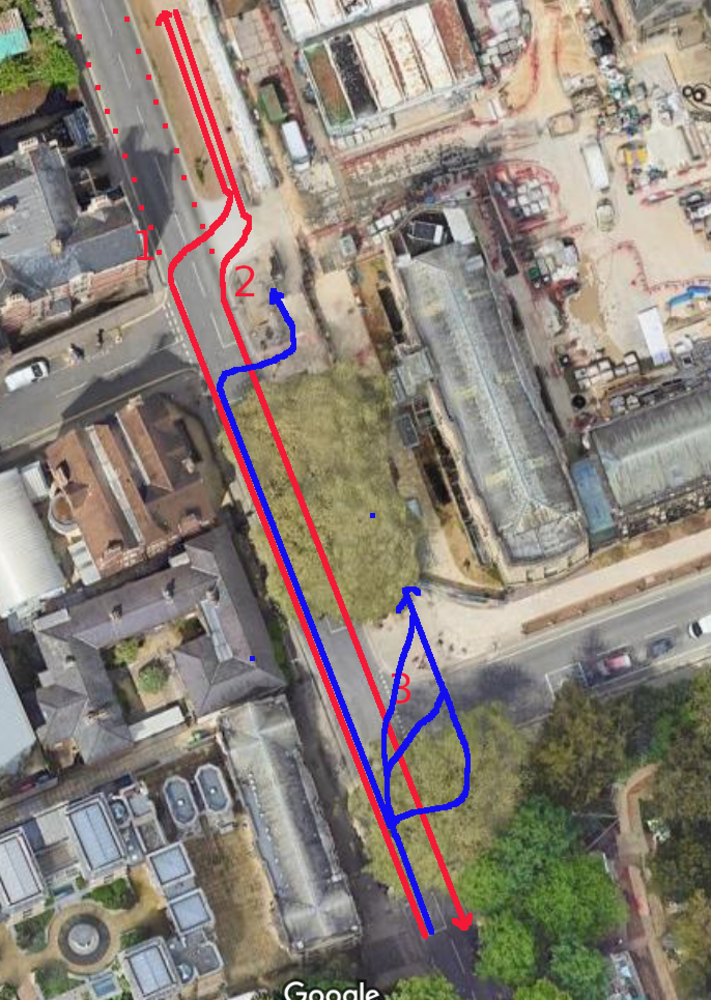
the approved/legal movements are in red and the actual ones (using the pedestrian crossings) are in blue - alternatively, people avoid using the cycle track at all (dashed red)
more
"The county should buy a unicorn and stable it on the Plain roundabout, where it will magically stop any collisions, alleviate all congestion, and make walking and cycling safe and accessible to all." This would probably make more sense than some of the transport proposals being bandied about - bus tunnels, removing cycling from main roads, etc. - but here I attempt to address some of the suggestions that seem sensible, but won't do what people want them to do.
Free public transport, segregated cycle tracks, School Streets schemes, traffic calming, Dutch style roundabouts, trams, and so forth are all potentially useful. But they only solve some problems, and in some cases require other measures to make them possible. They are not magically going to obviate the need for traffic removal and reduction - for low traffic neighbourhoods and measures such as traffic filters and the Zero Emission Zone. more
The legal changes to Broad St have been made permanent, but the current layout is clearly still temporary, in the sense that many of the features of the area no longer reflect its actual use. Most obviously, most of the existing kerbs are now redundant, or in the wrong place, and serve only as a trip hazard.
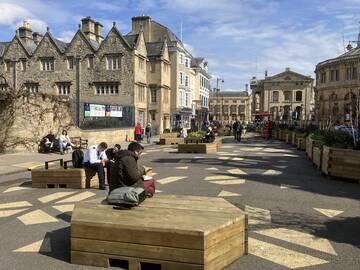
sitting around
A proper plan for Broad St needs to be part of a redesign of the entire area of the city centre north of High St and east of Cornmarket, as envisaged in the Oxford Preservation Trust's proposals twenty years ago, and any such plan will be dependent on funding which is not yet available. But there are possibilities in the management of vehicle access and parking for improvements that could plausibly be implemented in the shorter term. more
What is the road layout on Oxford's Iffley Rd and how is it supposed to work? The key features here are the use of advisory cycle lanes around a narrow central traffic lane with no centre line; between Donnington Bridge Rd and the Plain the cycle lanes are mostly 1.575m wide and the central lane ranges from 4.66m to 5.93m wide. (This was implemented on Iffley Rd as part of the "Quickways" schemes in 2022. A similar scheme was implemented on Magdalen Bridge in 2020; there the cycle lanes are 2m wide and the central lane is 5m.)
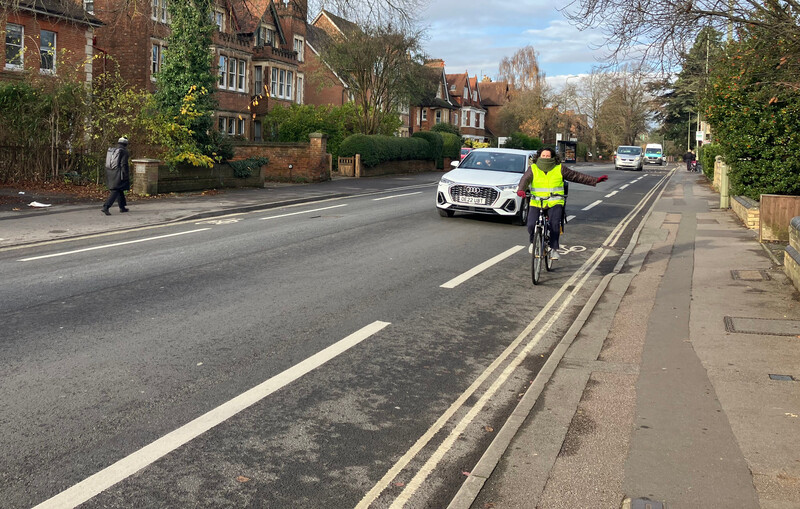
Iffley Rd
more
Contra-flow cycling should be allowed on all the one-way streets in Oxford. From LTN 1/20: "There should be a general presumption in favour of cycling in both directions in one way streets, unless there are safety, operational or cost reasons why it is not feasible." more
This outlines a plan for a direct, coherent east-west foot-cycle route across Oxford's city centre. That would run from the railway station across the north of Frideswide Square, along Hythe Bridge St, George St, Broad St, Holywell St, and Longwall St, ending at Magdalen Bridge.
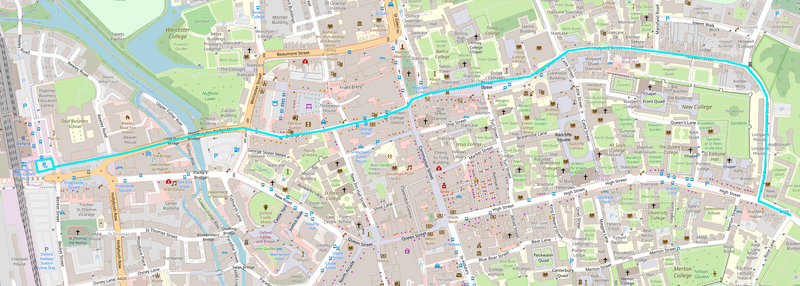 more
more
The current cycle training provision in our primary schools is inadequate and inequitable.
Imagine if primary schools ran a course on finance for Year 5 children, provided for free and taught in school time, but only offered to those children who already have an understanding of the basics - who already know what an interest rate is, say - and who already have a bank account of their own. That would, rightly, be condemned as hugely regressive, teaching children who are already privileged and knowledgeable even more, and exacerbating existing inequalities.
But this is exactly how cycle training works, certainly in Oxfordshire and I think across most of the country. more
Despite the research, I had always downplayed the psychological and social gains from traffic reduction, thinking of them as secondary to health improvements from increased physical activity - and perhaps as a bit "soft" and hard to measure. But my experience with the East Oxford Low Traffic Neighbourhoods has made me rethink this. more
Deaths and serious injuries — the target of Vision Zero — are just the tip of a much larger iceberg of road danger harm. In addition to the 20 road traffic fatalities and 450 serious injuries in Oxford over the last decade, there were 2800 reported slight injuries (all of those from the STATS19 police database) and (for cycling injuries, across Oxfordshire) ten times as many hospital admissions and attendances (this includes non-collision injuries which are rarely reported to the police). And there will be many minor injuries and collisions which are neither reported to the police nor result in hospital presentations. (Following Ling Felce's death at the Plain, I heard several people make comments like "Oh yes, I've been knocked off my bike twice at the Plain" and "No, I didn't report it either time.") There are even more near-misses and other incidents perceived as threatening. more
Oxford's Lye Valley area has poor walking and cycling connectivity, making it one of the more car dependent areas inside the ring-road (looking at 2011 census commute data). Two key routes could be upgraded to improve this, to the west across Lye Valley to the Churchill Hospital and to the south west over the golf course.
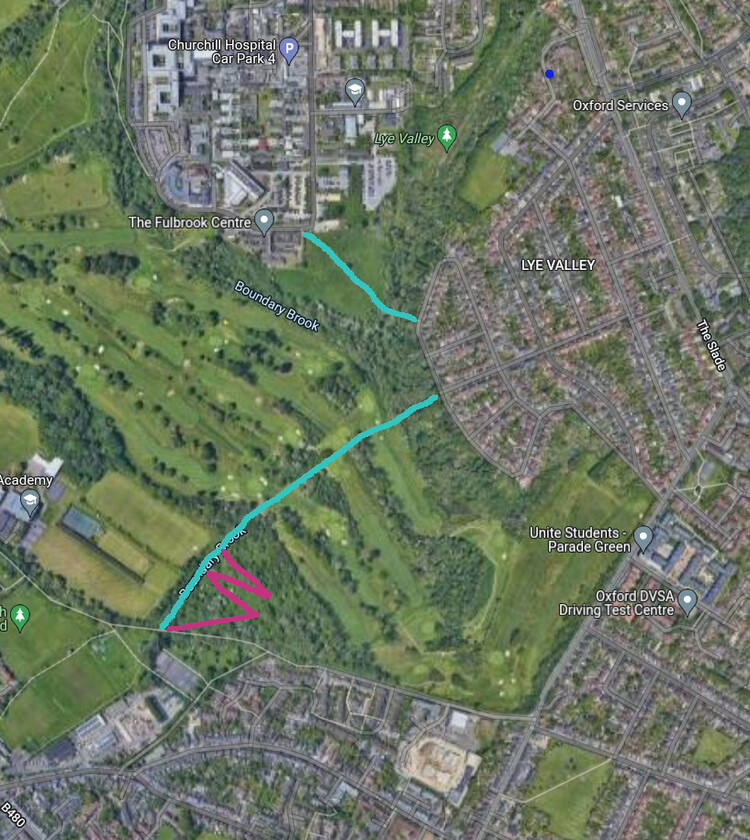
1) Put a proper foot-cycle track, with a bridge, across Lye Brook to the Churchill Hospital. 2) Upgrade the track across the golf course to Barracks Lane to an all-weather foot-cycle track, with a bridge across Boundary Brook to connect to Lye valley and potentially with zig-zags on the descent to Barracks Lane. This would require a legal change from a footpath to a bridleway. The likely form of any track would be a 3 metre wide shared path, with porous surfacing and embedded stud lighting, along the lines of the ones being put in across parks and fields elsewhere (e.g. across King Georges Field).) more
I think consideration should be given to turning off the signals at the northern end of Cornmarket and having that junction operate like the Holywell junction at the other end of Broad St.
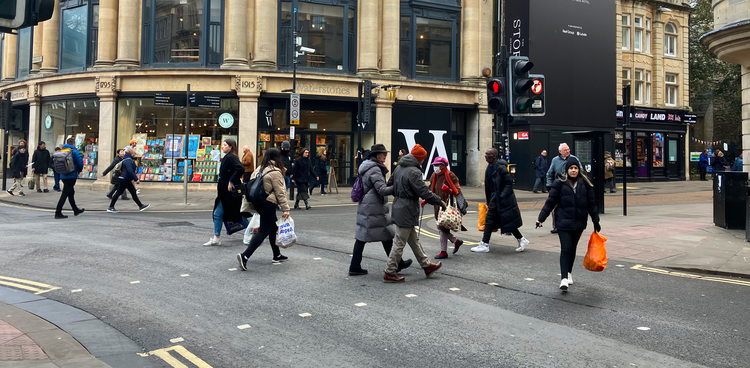
I walk and cycle through this junction regularly, and there's pretty much always:
- a stream of pedestrians crossing on red across George St, as in the photo above - if they didn't they'd pile up and block the footways;
- pedestrians crossing haphazardly across the unsignalled Magdalen St West and Broad St arms, sometimes getting caught out mid-crossing by signal changes;
- mopeds and cycles going through red lights or using the wrong side of the road to turn from Broad St into Magdalen St West; and
- significant periods when buses and taxis and cycles are waiting even though the junction is clear.
more
The Charlbury Rd area in north Oxford has a major problem with road danger at school drop-off and pickup times. Large numbers of school-run vehicles arriving and stopping and departing in a short period of time create congestion, along with turning and reversing movements that endanger people walking and cycling.
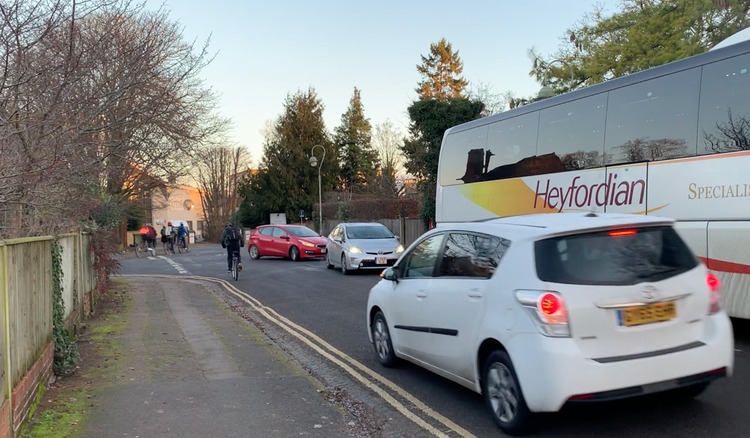 more
more
Wherever possible, space for cycle or scooter parking should be taken from car parking space or spare carriageway space, not from footways or space for pedestrians. Pedestrians are at the very top of the transport hierarchy and private cars at the very bottom.
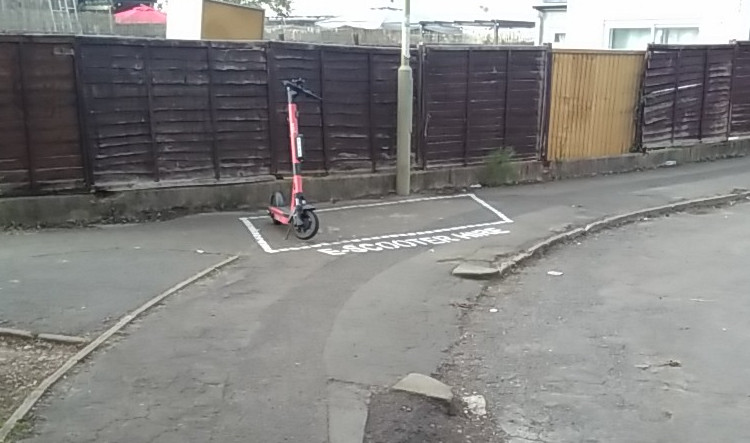 more
more
The Oslo Street Design Manual (in English) is useful. In particular, it has guidance for cycling infrastructure provision in the presence of hills, which is lacking from Dutch guidelines and standards.
But a very important flowchart, for determining what cycling infrastructure is needed in different circumstances, has two errors in it!
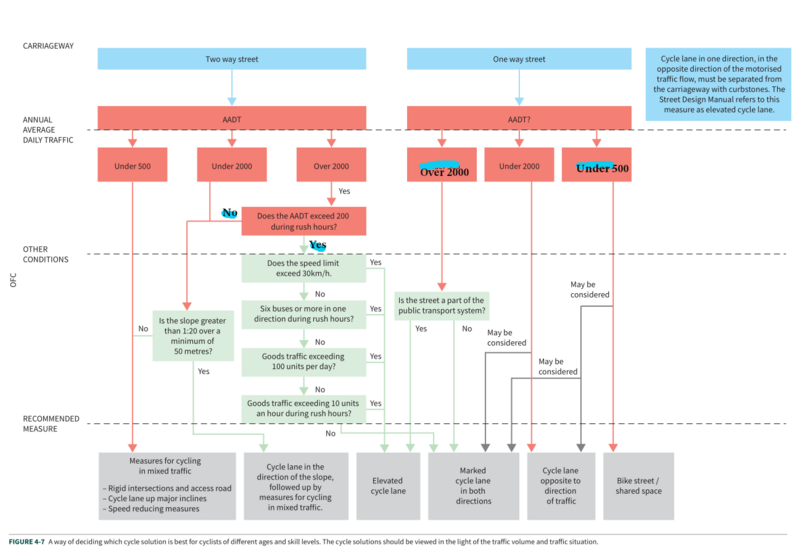
the key flowchart, with corrections
While the county should continue to support schemes for schools that request them, having that as the only way for schemes to happen will limit the effectiveness of the program. The county should proactively plan School Streets schemes at those locations where they will have the most effect. more
Oxfordshire's cabinet recently adopted a "decide and provide" approach for transport planning, but that doesn't seem to be informing the plans for the traffic filters in the Central Oxfordshire Travel Plan. The St Cross traffic filter and cycling on Magdalen Bridge provides one example of this. more
The junction of Longwall St and High St, in Oxford, poses some unusual design challenges. Along with Magdalen Bridge and the Plain roundabout, it is a key bottleneck in Oxford's transport network — this segment is probably the second busiest cycle route in the UK and likely the second busiest bus route. There are huge problems with this junction as it is, but the core schemes in the forthcoming Central Oxfordshire Transport Strategy offer a chance to redesign it.
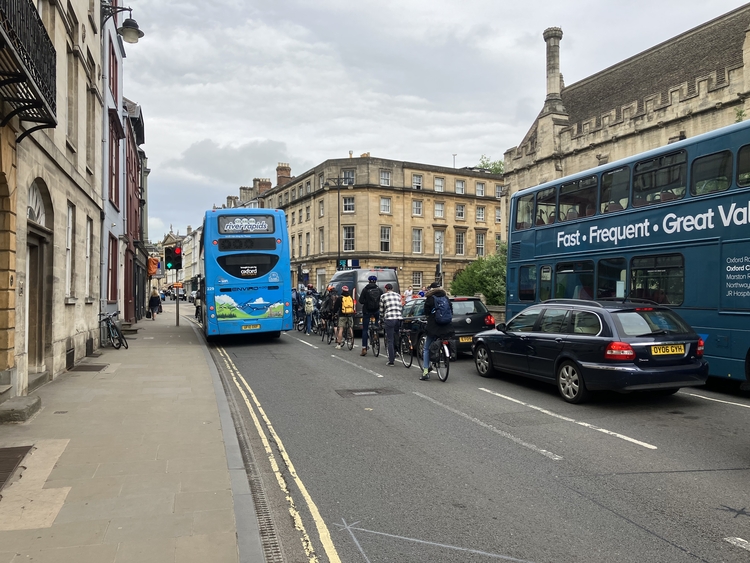
people cycling wanting to turn right into Longwall have to wait in a one metre wide lane with motor traffic on both sides
more
A look at the new Warneford Lane cycle tracks, put in in 4-7 July 2022.
more

